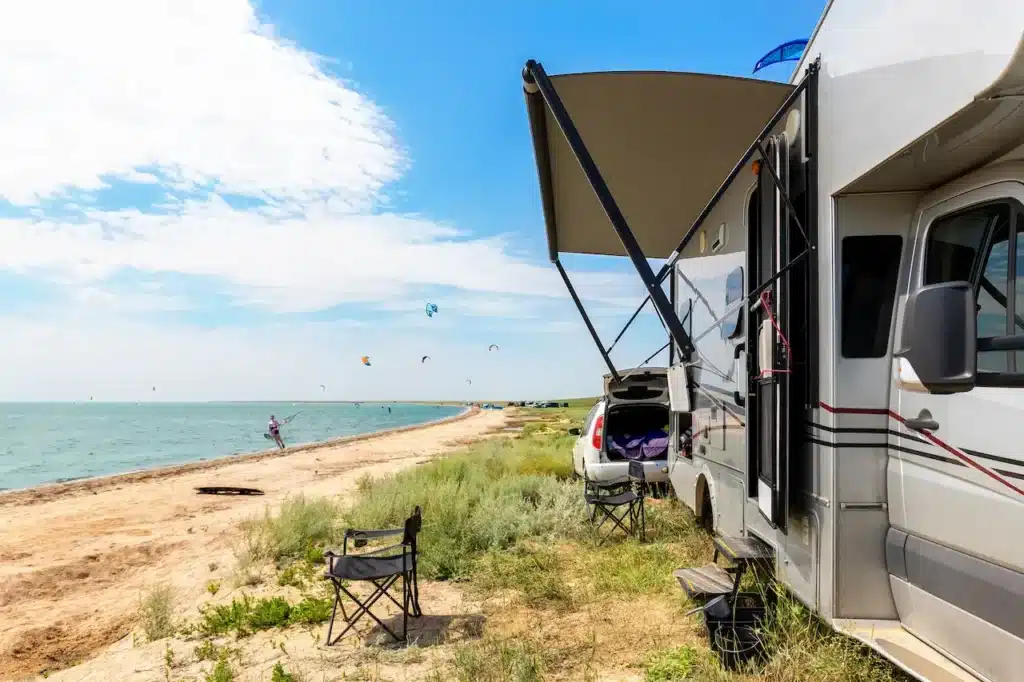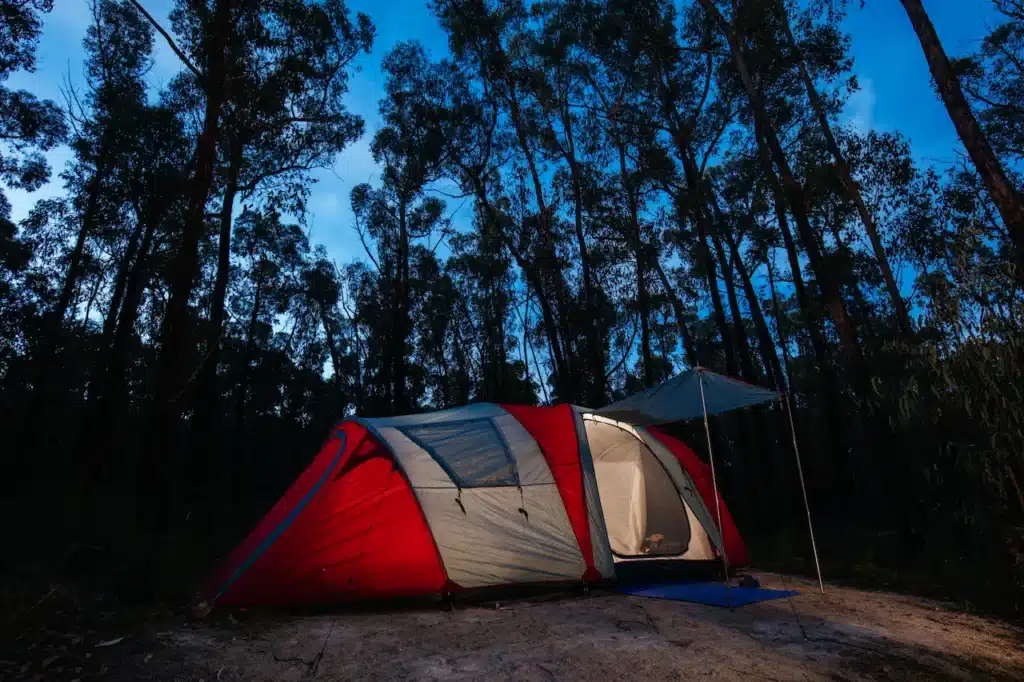Australia is one of the best camping destinations in the world. The Camping Guide for Australia explains why this adventure is a must-do on anyone’s bucket list.
Our Guide to Camping in Australia will show you where to find free camping, the best beach camping and outback spots, and how to select the right camping gear. We’ll also give you a few camping tips and tell you about some of Australia’s most beautiful camping spots. You’ll find everything you need to know about your next camping trip.
Australia is one of the best camping destinations in the world. Its lush rainforests, stunning coastlines and outback landscapes are amongst its most popular attractions. It’s a camping adventure that deserves to be at the top of your bucket list. With wildlife as company, starry skies for sleeping under, and campgrounds surrounded by natural wonders.
You may be wondering how you can conquer Australia on the camping trip of your lifetime. You’ll never be able to see everything in Australia, but attempting it might be your biggest travel goal.
We’ve created a guide to help you plan your trip. It includes information on the best camping spots in Australia for beach lovers and the outback.

The Ultimate Australian Camping Guide Includes:
- What is the best camping equipment?
- Best times to camp
- Camping on the beach is a great way to enjoy nature.
- Outback camping: Where to go?
- Top free camping sites
- Ten top Australian camping tips that you should know
You need to decide whether you are going to take a campervan or a tent camping.
You’ll always find both types of campgrounds, so make your choice based on your own needs. If you want to enjoy the comforts of your home, then a campervan equipped with a fridge, stove, sink and bed above the ground is the perfect choice. A tent is the best option for the adventurous traveller who wants to experience the outdoors.
Camping is very popular in Australia. You can hire or buy equipment in all capital cities and large towns. Here’s what you need if you decide to bring a tent:
- With a groundsheet or tarp, you can easily assemble a tent of good quality and durability that is waterproof.
- Sleeping gear includes inflatable or self-inflating mattresses, sleeping bags, and pillows.
- A camping fridge or esky.
- You’ll also need a camping stove, a gas bottle, a kettle, plates, cups and eating utensils, as well as a bucket and sponge for cleaning up.
- Camping chairs and tables
- Torches, gas lamps or solar-powered lights are all options.
- Towels, clothes pegs, and wet weather gear are included in the first aid kit.
If you’re looking to explore Australia’s best campgrounds in comfort and with less setup time, then consider renting or buying a campervan or car.
Station Wagons
If you’d like to take a tent, but would prefer to sleep in your vehicle in case of bad weather, a station wagon is the best option. You can find them all over the country, and they come with cooking equipment and an esky. They can seat between two and five people, so you will also save on petrol.
Rent a station wagon from Travellers starting at $35 per day. You will get free campsites, discounts at caravan parks, 24/7 roadside help, unlimited kilometres, and a toll-free service number. The cost of buying a car ranges from $3000 to $6000.
Campervans
Campervans are the perfect way to see as much of Australia on an extended camping holiday. They come with all the little comforts you need, such as kitchen sinks, power plugs, and gas stoves. You’ll find vans that are suitable for everyone, from backpackers and families to groups.
Cost: Hire a campervan at Travellers for $35-$85 per day. You’ll get access to free campsites, discounts in caravan parks, 24-hour roadside assistance, and a toll-free service number.
When is the Best Time to Camp
Australia is known for its sunny days, clear skies and blue skies. However, extreme weather conditions can make or ruin a camping trip. Here are some places to visit to enjoy the best seasons.
Southern States
Camping enthusiasts should choose Tasmania’s unspoiled wilderness or Victoria’s food-and-wine trails. Australia’s southern states experience seasons similar to those in Europe, with dramatic landscape changes. Winter temperatures can drop to as low as -7degC, but in the Alpine region. Camp between October and April when temperatures are comfortable, averaging between 20-28 °c.
Subtropical States
Camping is possible on the beach or in the middle of the outback across Northern and Central New South Wales, as well as South Australia, Southern Queensland, and Southern Western Australia. The coastal regions have hot summers that are perfect for swimming, and cool winters, but rarely freezing. The temperatures in the inland regions can be more extreme. However, you can camp throughout the region all year.
Tropical States
You can enjoy temperatures between 25 °c and 35degc °c in North-Western Australia and North Queensland all year round. You should also consider the dry and wet seasons.
The wet period runs from November through to March. While places like Kakadu National Park look lush and green, it is best to leave camping in these areas to 4wd campers who are experienced. Some campgrounds close for the season due to flooding. It’s also stinger season in North Queensland, and the humidity is at its peak.
The dry season in the Tropics runs from April to October. Enjoy the beautiful scenery and the perfect weather to spend time outdoors.
Central Australia
Want to visit Australia’s stunning Outback landscapes, including Uluru, but never had the chance? It is best to visit the Red Centre, West MacDonnell Ranges, Simpson Desert, Flinders Ranges, and Tennant Creek between April and October. You’ll be able to avoid the heat of summer when temperatures can reach up to 40degC.

Most Breathtaking Beach Camping Spot
Camping by the sea is a great way to spend your time. There are more than 10,000 beaches to choose from. Check out some of the most beautiful beachfront camping sites in the United States.
Johanna Beach, Victoria
The campground at Johanna Beach, nestled in Otway National Park, is the ideal base to explore the Great Ocean Road. You can pick up your Campervan in Melbourne. Just remember to bring your own water and cooking equipment. You can then relax, surf, hike or whale watch while enjoying the spectacular ocean views.
Jervis Bay, New South Wales
Jervis Bay is home to the Booderee National Park as well as the popular Green Patch campground. You can snorkel in the calm waters that lap powder-soft white sand, and see wallabies as well as king parrots, rainbow lorikeets, and rainbow birds. The Wreck Bay Aboriginal Community owns the park, which offers cultural programs, bush tucker hikes, and campfire tales. Jervis Bay, located three hours from Sydney, is where you can rent your equipment.
Lucky Bay, Western Australia
There are many campgrounds to choose from in Western Australia when you hire a campervan in Perth. Lucky Bay is near Esperance, where you can swim in turquoise waters while watching kangaroos relax on the beach. In the Cape Le Grand National Park, a five-kilometre stretch of idyllic sand is found. Picnic areas, toilets, showers and barbecues are available at the campground and caravan.
Noah Beach in Queensland
It is hard to imagine that you can camp in the rainforest while also being on the beach next to the Great Barrier Reef, but Noah Beach will make your dream a reality. Leave Cairns to head towards Cape Tribulation, in the beautiful Daintree Park. Bird watching, picnics on the beach, snorkelling with abundant marine life, and exploring the heritage-listed forest are all options.
Where to Camp in the Outback
Camping in Australia’s Outback offers solitude, serenity and breathtaking landscapes. These top places offer a glimpse into Australia’s unique culture and wildlife.
Ayres Rock, Northern Territory
Get your Campervan and camping supplies in Darwin to go on a camping adventure through the Northern Territory. Ayres Rock Campground lies within Ayres Resort, so you can sleep right under the gaze of this incredible sandstone monument. You’ll feel right at home in the Outback with facilities such as a swimming pool, barbecues, self-service laundry and an outdoor cooking area.
Kilcowera Station in Queensland
Kilcowera is a working cattle ranch 1200 km west of Brisbane. You’ll find Red Kangaroos, parrots in Coolabahs, and wetlands filled with birds. Campers are welcome from March to October. It has all the amenities you’ll need. You can go yabbying or swimming in the waterholes. Currawinya National Park can be explored on a day trip.
Mungo National Park in New South Wales
World Heritage Mungo National Park contains the oldest human remains outside of Africa, the Mungo Lady and Mungo Man. Main Camp, located near the Visitor Centre and Mungo Woolshed, is a great place to stay. From Sydney, you can drive to Mildura and Wentworth.

Grampians Victoria
The Grampians are a region of mighty sandstone mountain ranges, roaring falls, colourful wildflowers, and abundant wildlife. Grampians Paradise Camping & Caravan Parkland is just a 3-hour drive away from Melbourne. Kangaroos, Kookaburras, and breathtaking mountain views will keep you company.
Bungle Bungles, Western Australia
The Bungle Bungles are a world-famous landmark. Purnululu is a national park in the Kimberley area. The orange and black domes reach a height of 300 metres. The Bungle Bungle Caravan Park is a gathering place for travellers from around the world, and has a communal fire pit.



